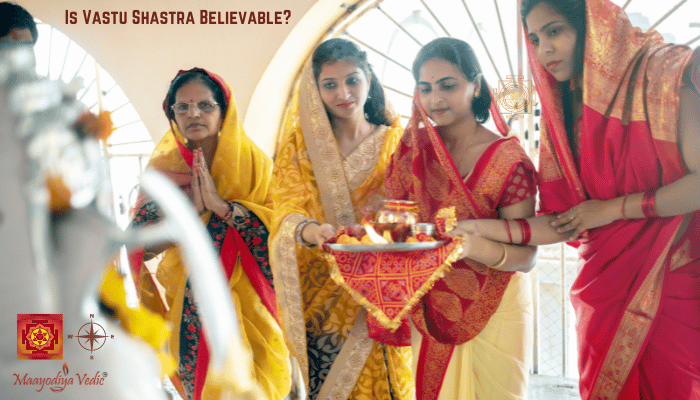There are various forms in which people believe they can live in perfect harmony. Following which various rituals and practices are derived out of these philosophies. One popular practice which has made its way to the current era is Vastu Shastra. But with all the logical and scientific breakthroughs, the belief in these ancient practices gets questioned. Is Vastu Shastra believable? is a question that often arises in a layman’s mind. Vastu Shastra is an ancient Indian architectural system and design that tries to establish a connection between the edifices and the earth’s natural universe. It is believed that the construction of buildings and spaces according to this practice would bring in harmony and prosperity, good health, and happiness. But when it comes to the actual practice, Vastu Shastra is often questioned for its credibility. This often becomes a dilemma for the homeowners and the architects.
The Clash Between Tradition and Modernity
In the current era, everything needs to be scientifically proven. People who negate the practice of Vastu Shastra often deny its working and term it as superstition. They believe that there is no logical evidence to prove that it exists. Whereas there are people who believe and live in harmony with the construction based on Vastu principles. They credit their happiness and prosperity to their Vastu homes. This often leads to confusion and a state of indecisiveness in people who aspire to build or remodel their homes according to Vastu tips. It becomes a tough call to judge whether Vastu Shastra is a proven scientific architectural practice or just a part of culture.

Exploring Vastu Shastra’s Credibility
Importance of Vastu Shastra in Modern Homes
Vastu Shastra is the Indian science of architecture; it is based on the sundry concepts which help to balance the natural energies in the surroundings where we live. As per Vastu principles, the layout and positioning of the building in relation to the sun and the planetary bodies ensure the positive energy flow. Today, in any standard home, each and every aspect of Vastu is meticulously followed as it is believed that it affects the wellness and prosperity of the inhabitants. For instance, the main entrance in any home is allowed towards the northeast as it is believed that it allows the inflow of positive energy in the home. Further, it is thought that an entrance opposite the main door should be avoided as it slows down the inflow of energy in the home and also creates an imbalance in the north-east axis. Similarly, it is recommended that one should not clutter the home as it hampers the natural flow of energy; rather the furniture should be arranged in a way that there is free movement in the room. It is believed that all these practices when adhered to create a harmonious being between the resident and the surroundings, thus promoting physical and mental well-being. Vastu tips are also recommended during the construction of a home, as certain directions and levels in a building are said to affect the fortunes of the occupants. For instance, the Pooja room is allowed in the east or north direction and should be on the highest floor level as it is considered to bring in prosperity and good fortune in the home. Further, the kitchen in a home is allowed towards the north or east with a suggestion to construct the toilet towards the south or west as it promotes harmony in the home.
Vastu Shastra Myths vs. Facts
Myth 1: Vastu Shastra as Only Superstition
Vastu shastra has been discredited by many who view it as nothing but superstition without any scientific basis. However, this is not true. Whereas some of the Vastu recommendations may seem esoteric, others are based on architectural practices which aim at improving air circulation, illumination and space management.
Myth 2: Instant Success Guaranteed with Vastu Shastra
Many people also think that by following the principles of vastushastra they can get instant success and wealth. The truth is that vastushastra creates an environment where prosperity can thrive; it does not lead to a specific result. Achieving personal success and well-being therefore depends upon various factors from our own lives as well as external determinants.
Myth 3: Inflexible Vastu Shastra
People often believe that Vastu Shastra is rigid and cannot be adapted into modern architecture. On the other hand, while maintaining their essence, it is possible to interpret and apply the principles flexibly so that they go along with contemporary design.
Fact 1: Vastu Allows Natural Lighting and Ventilation
Maximizing natural lighting and ventilation is one of the basic principles of Vastu Shastra. For a healthy living, it is essential that the house gets ample amount of fresh air and natural light. Properly placed windows and doors help in achieving this goal and are beneficial for the overall health of the residents.
Fact 2: Vastu Promotes Balance in Spaces
Another important factor that Vastu Shastra focuses on is the balanced placement of various sections in a building. Even after the construction of the building, the furniture and other items in each room should be placed in a balanced manner. This sense of harmony pleases our mind and has a great impact on our mental health.
Vastu Shastra Scientific Evidence
Although Vastu Shastra is ancient, scientific evidence is lacking in some areas and present in others. Any building should consider nature’s principle for lighting and ventilation, which is also mentioned in Vastu Shastra. Environmental psychology and modern architecture consider this principle important for better living, productivity and job satisfaction. Natural daylight is known to boost mood and productivity according to various studies.
Furthermore, proper cross ventilation ensures indoor air quality and is associated with better health as per recent studies. The principle of organizing space in a particular area is also followed in modern interior design and ergonomic studies, which is another principle also mentioned in Vastu Shastra. Thus, certain principles of vastu are scientifically proven while others like directional forces of various rooms, grid system, symbols and so on have no scientific evidence and are merely interpreted culturally or traditionally.
Vastu Shastra Impact on Mental Well-being
This is the most widely accepted reason for following Vastu Shastra. People believe that or friends who live in a vastu compliant home are more stress free, have better mental clarity and peaceful. This is because nature’s principles are followed which helps in balanced and holistic environment.
Studies in environmental psychology show that our surroundings have a direct and indirect impact on our mental well-being. Certain principles like natural daylight, organization in the space, colors of the walls and furniture and so on even affect our mood and cognitive abilities. Hence, following principles of Vastu Shastra which are in accordance with nature’s principles can aid in holistic living. Psychological studies can further be done to verify the effects of vastu on mental health. For example, a study could assess the I.Q of children in two houses, one following vastu and the other not.
Read Also: Vastu Shastra for Water Tank
Conclusion:
So, is Vastu Shastra believable? It’s an answer to this question can be found at the confluence of three different paradigms: that of tradition, that of individual belief and that of science. While some of the Vastu Shastra principles are in line with modern architecture and do have a scientific basis in environmental psychology, other parts of this ancient system are based on cultural and traditional authority and go unvalidated by the scientific method.
For its practitioners, Vastu Shastra provides a checklist of things to do and things to avoid in order to create an optimal and balanced living space that fosters well being. For the skeptics, it presents an exciting journey in how ancient traditions can be used to support modern day lifestyle.
Building or creating modern homes by following Vastu principles is a personal experiment of tuning in with the nature and its forces. You can be a strong Vastu believer or a curious onlooker but to understand the Vastu Shastra principles and how they can affect your life is always a great experience. At the crossroads of tradition and modernity, Vastu Shastra presents a unique outlook towards understanding how we can nurture and create healthy environments which in turn nurtures and sustains us.
FAQs:
How much history is there to Vastu Shastra?
Vastu Shastra originates in ancient India several thousands of years ago. It is referred in ancient texts like vedas and considered as the predecessor of feng shui which is the Chinese practice of balancing human life with the natural world. The principles of Vastu were traditionally followed for building temples, palaces and houses in a harmonious balance with cosmic forces.
Is Vastu Shastra effective?
Vastu Shastra is effective if you believe in its energy and if you choose to experience its positive vibes. Some find it effective and there ives who just don’t get it. There is very little scientific evidence of Vastu working and its effects could be purely psychological. What vastu Shastra practice does is, it instils a sense of conscious living with a sense of purpose which is always helpful. So believe in it, and let the positive energy flow!
In what ways Vastu Shastra can impact your life?
The purpose of Vastu Shastra is to provide a healthy, happy and prosperous environment to live in. Vastu through its principles optimises natural light, ventilation, spatial flow and balance which in turn creates a positive environment. This positive surroundings affects our mental and physical health.
What is the scientific basis to some of the Vastu principles?
There is indeed some common ground between Vastu principles and modern architecture and psychology. For example, natural light and ventilation are considered to be of paramount importance for healthy living as established by modern science. However, there is no scientific evidence to support the directional forces, magnetic grids, chakras, symbols and figurative representations and hence are usually difficult to explain except through the traditional and cultural perspective.
Does Vastu Shastra help in improving relationships and prosperity?
The goal of Vastu Shastra is to bring balance and harmony in ones surroundings which in turn improves relationships and prosperity. A well organized and structured home reduces stress and anxiety which in turn improves mental health and relationships. Vastu Shastra is not a miraculous technique to get whatever you wish for. It is a part of overall efforts and cannot be blamed if you are not prosperous or don’t have good relationships.
